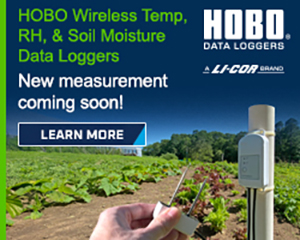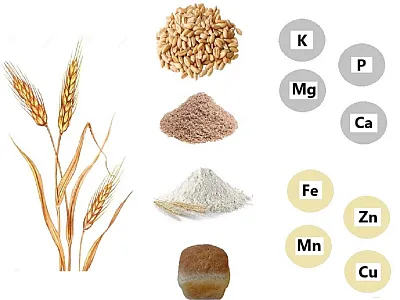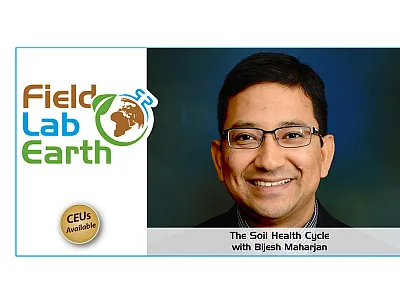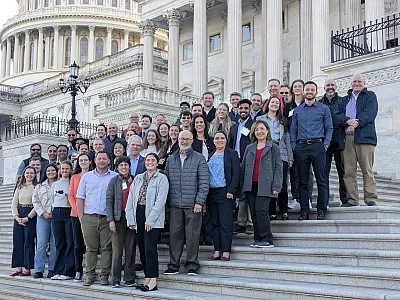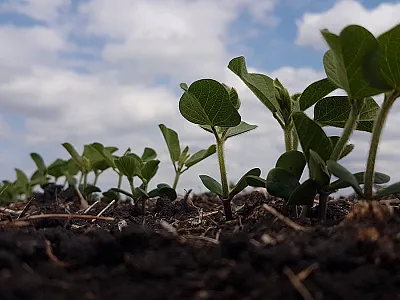Potential Blind Spots and Hot Spots for Nutrient Loss


The application and fate of nutrients are two of the biggest questions agriculture faces today, affecting everything from profit margins to water quality. Researchers work to examine the issue from all angles, such as the kinds of fertilizers widely used in the United States to how the topography of a field can impact the distribution and runoff of nutrients. In this article, we look at two recent research articles that approach these questions from different angles. One sees the nitrogen content of ammonium phosphate fertilizers as a “blind spot” in nitrogen budgets. The other sees farmed prairie potholes as potential “hot spots” for nutrient runoff downstream. Earn 1 CEU in Nutrient Management by reading this article and taking the quiz at https://web.sciencesocieties.org/Learning-Center/Courses.
The application and fate of nutrients are two of the biggest questions agriculture faces today, affecting everything from profit margins to water quality. Researchers work to examine the issue from all angles, such as the kinds of fertilizers widely used in the United States to how the topography of a field can impact the distribution and runoff of nutrients.
Two recent research articles—one in the journal Agricultural & Environmental Letters and another in the journal Agrosystems, Geosciences & Environment—focus on this broad topic, yet approach these questions from different angles.
Andrew J. Margenot, an associate professor of soil science at the University of Illinois Urbana-Champaign, is the lead author on a commentary calling for a more critical look at the nitrogen content of ammonium phosphate fertilizers. He believes they are a “blind spot” in the nitrogen budgets of many cropping systems.
In terms of “hot spots,” Rose Tirtalistyani, an agricultural and biosystems engineering doctoral student at Iowa State University, led work on assessing nutrient flow through farmed prairie potholes. During the study period, the research fields experienced higher-than-average precipitation, and the potholes had elevated levels of phosphorus runoff to nearby waters.
Small Amounts of Ignored Nitrogen Add Up
Margenot’s work points out that while ammonium phosphate fertilizers — namely monoammonium phosphate (MAP), diammonium phosphate (DAP), and ammonium polyphosphate (APP) — are common sources of phosphorus for crops, they also contribute an appreciable amount of nitrogen that should not be ignored. Based on data from the Food and Agriculture Organization (FAO) of the United Nations, this “extra” nitrogen represents 8% of the nitrogen applied to crop systems across the globe.

Even a small amount per acre can scale to a large amount in a big region with hundreds of millions of acres, with Illinois being just one example. “I think this has been ignored for so long because we think of these as sources of phosphorus and not nitrogen,” Margenot explains. “The nitrogen is considered ‘extra’ at best, as evidenced by many recommendations out there. For example, many recommendations do not count the nitrogen applied through these fertilizers, especially when fall applied, in the total nitrogen rates for corn. They aren’t even considered by the USDA to be nitrogen fertilizers.”
For example, 100–150 lb/ac of DAP — which is 18% nitrogen (N) — for corn would equal 18–27 lb N/ac, but corn in the Midwest typically receives 180–220 lb N/ac, so the DAP is only contributing approximately 10% of the main nitrogen application in magnitude. This is not nothing, but a small enough magnitude that it is usually overlooked, Margenot says.
Margenot and his colleagues identified a gap in knowledge when it comes to evaluating the fate of nitrogen from ammonium phosphate fertilizers. Extra nitrogen can be lost via leaching from the soil into surrounding waterways, harming water quality. In addition, it can be lost to the atmosphere by denitrification, which has the potential to be a greenhouse gas. However, they did not find a single published study that explicitly evaluated the leaching and/or gas loss fates of nitrogen from MAP or DAP.
“In the U.S. context, this is a big deal given our nitrate-N loss challenges in the Mississippi River basin and the dominant use of these fertilizers as a phosphorus source,” Margenot says. “For example, Mississippi River Basin states need to reduce nitrate-N by a set amount by the interim deadline of 2025. For Illinois, as outlined in the state’s Nutrient Loss Reduction Strategy, our interim goal for 2025 is 15% nitrate-N loss reduction and a final loss reduction of 45%.”
For context, Illinois’ 15% nitrate-N loss reduction goal is equal to 60 million pounds of nitrate-N per year, and the 45% reduction goal is 179 million pounds of nitrate-N per year. Reduction in these standards is measured relative to 1980–1996 losses as the baseline.

Fertilizer Application Timing, Source Matter
Margenot notes that this work points to two main messages for farmers. The first is that the timing of fertilizer application — fall versus spring — can have big consequences on the amount of nitrogen leaching into the environment. As winters become warmer across the country, but particularly in the southern Corn Belt, fall-applied MAP or DAP can increase the risk of nitrogen loss from leaching or runoff and gas loss.
“While fall applying these fertilizers may make sense from a logistical perspective as fields are generally drier in the fall, it is a waste of the ‘extra’ nitrogen and poses issues for water quality,” Margenot says. “Fall-applied monoammonium phosphate or diammonium phosphate is an increasingly bad idea as winters become warmer.”
Crop advisers and farmers can also consider how they manage phosphorus as part of nitrogen and phosphorus management to encourage better crop use efficiency and water quality. For example, Margenot says field experiments demonstrate no yield differences in switching the timing and source of phosphorus—which is expected—but that there are big benefits to cutting back on nitrogen inputs by counting nitrogen applied via ammonium phosphate fertilizers in the spring.
In addition, nonammoniacal phosphorus sources also exist, such as triple superphosphate (TSP). The researchers note that the availability of superphosphates is often limited, and while it used to be a recommended phosphorus source, U.S. industry lobbying, market trends, and tariffs have all contributed to a decline in use.
“This work highlights the need for better phosphorus fertilizer options,” Margenot says. “In particular, triple superphosphate has tremendous potential to provide environmental benefits and help us meet our nitrate-N loss reduction goals. We need more support for TSP in the U.S. market, including getting rid of questionable tariffs on imported TSP.”
To Margenot, even approximate back-of-the-napkin math makes a strong case for pursuing these solutions. Based on conservative assumptions, so much nitrogen is lost from fall-applied ammonium phosphate fertilizers that a spring application would save enough nitrogen to exceed Illinois’ 2025 reduction target and be halfway to the 45% target. For example, if only half of the 21 million acres of Illinois cropland going into the corn phase of a corn–soybean rotation receive 200 lb of DAP per acre application, a common rate, then 198 million lb of nitrogen are being applied—and largely in the fall—across Illinois. This exceeds the 45% reduction goal. Switching to spring application and/or nitrogen-free phosphorus forms, notably triple superphosphate, therefore, offer high potential to decrease nitrate-N leaching.
"Triple superphosphate has tremendous potential to provide environmental benefits and help us meet our nitrate-N loss reduction goals. We need more support for TSP in the U.S. market, including getting rid of questionable tariffs on imported TSP.”

“By switching from fall to spring application or simply using nitrogen-free phosphorus source like triple superphosphate, we can put a serious dent into, or theoretically achieve, our nitrate-N reduction goals,” he explains. “This research identifies a rare low-hanging-fruit strategy to reduce our nitrogen losses without changing the ‘main’ nitrogen application rate for corn and without touching how much phosphorus is added. Because this has been overlooked, we have gains that can be made relatively easily. In other words, we haven’t considered how managing phosphorus can yield benefits for nitrogen loss reductions.”
“This research identifies a rare low-hanging-fruit strategy to reduce our nitrogen losses without changing the ‘main’ nitrogen application rate for corn and without touching how much phosphorus is added."
Elevated Nutrient Levels in Prairie Potholes Can Move Downstream
We now move from nutrient blind spots to hots spots and from Illinois to the Prairie Pothole Region of the United States, a region spanning five states—Iowa, Montana, North Dakota, South Dakota, and Minnesota—and extending into Canada. Rose Tirtalistyani describes prairie potholes as geographically isolated wetlands—often called ephemeral wetlands—that can have a wide variety of characteristics, from topography, agricultural systems, and relation to groundwater. These all cause differences in how the potholes serve as aquatic systems and hold on to ponded water.
An area called the Des Moines Lobe is the tip of the Prairie Pothole Region that is located in Iowa. Here, Tirtalistyani says, more than 90% of potholes have been disturbed by artificial drainages to support agriculture in the area and are called farmed prairie potholes. Farmed prairie potholes are often unique in their environmental interactions and impacts, sharing similarities with both wetlands and farmlands. These potholes are often inundated, particularly during periods of heavy rain like in early spring and summer.
Tirtalistyani led a study to monitor 10 farmed potholes during a wet year that received 32% higher rainfall than the 30-year average. Soybeans were planted during the study year. The potholes at the research sites vary in size from 1.2 to 12.3 ac. The researchers say past work by others in the Des Moines Lobe has shown the average pothole’s size is 3.2 ac, ranging from 0.01 to as large as 494 ac.

"The elevated nutrient concentration in the potholes’ standing water can be transported directly to downstream waters such as rivers and might lead to hypoxia or algae blooms.”
Their findings show that these farmed prairie potholes can be inundated with water for up to 80% of the growing season, even with subsurface drainage installed underneath them. While the water quality inside the potholes themselves does not harm cropland, flooding of the potholes in early spring and throughout the growing season can be difficult for farmers to manage. For example, prolonged flooded conditions may result in crop loss or tough terrain for the grower to operate on.
“High precipitation and no fertilizer application during the soybean year lowered the nutrient concentrations in potholes inundated with water compared to dry and corn years,” Tirtalistyani explains. “With subsurface drainage system and prolonged inundation, these potholes may contribute elevated levels of phosphorus to downstream waters, as dissolved phosphorus slowly releases from the soil to the water. The elevated nutrient concentration in the potholes’ standing water can be transported directly to downstream waters such as rivers and might lead to hypoxia or algae blooms.”
The researchers observed differences between how nitrogen and phosphorus behave in the potholes. For nitrate, levels are usually higher in the spring due to excess nitrogen in the field not taken up by the crop being flushed out with excess rainfall. On the other hand, phosphorus concentrations may increase over time as the pothole continues to be inundated because phosphorus from the soil is slowly released into the ponded water in the potholes. The researchers found that especially with the subsurface drainage underneath the pothole, these high phosphorus and nitrate concentrations in pothole water can be transported to downstream water.
“It is important to understand how these potholes behave under different precipitation amounts and intensity,” Tirtalistyani says. “The coming challenges and uncertainty of a future climate may influence how these prairie potholes will function in terms of the nutrient concentration, crop survival, and wildlife ecosystems. Precipitation variations and changes may impact ponding duration, volume, and water quality dynamics within the pothole.”
Management Strategies for CCAs and Their Farmer-Clients
Based on their work and others’ research, the scientists note several strategies crop advisers and growers have available to alleviate issues prairie potholes can present. While not possible for everyone, one option is restoring the potholes to their natural state, so they can assist in minimizing flooding, replenishing groundwater, and enhancing water quality.

For farmers who wish to keep their potholes in production, Tirtalistyani shares several options:
Improving soil health through practices like reduced tillage can help soil infiltration and reduce the flooding of the potholes somewhat by reducing the surface runoff that fills them.
Any strategy to improve nitrogen management and reduce losses, such as connecting subsurface draining to a subsurface bioreactor, can be beneficial.
Something called a blind inlet, instead of a surface inlet, is an option to cut down on the leaching of phosphorus. A blind inlet uses a gravel trench to allow water into the subsurface drainage system, rather than piping.
Phosphorus-absorbing material can be added to the gravel in a blind inlet as an additional phosphorus-reducing step.
Tirtalistyani hopes to continue this work and improve the ability to predict the inundation patterns of prairie potholes and their impact on water quality. In addition, the researchers plan to explore if these periods of inundation impact crop yield and how different management techniques or perennial crops can be a more profitable option for growers.
“Prairie potholes systems are complex, despite their small size, with many processes occurring inside them,” she says. “There is a big opportunity for extensive research about potholes in various fields, including potential conservation practices specific to this unique system, the application of models for simulating its complex processes, and an exploration of how this seemingly small system might play a role in addressing substantial issues like climate change.”
Dig Deeper
View the original research mentioned in this article:
Margenot, A.J., & Lee, J. (2023). The fate of nitrogen of ammonium phosphate fertilizers: A blind spot. Agricultural & Environmental Letters, 8, e20116. https://doi.org/10.1002/ael2.20116
Tirtalistyani, R., Rempe, I., Long, L.A., Soupir, M., Kaleita, A., & Nahkala, B. (2024). Inundation and nutrient assessment of farmed prairie potholes during a cropping season with high precipitation. Agrosystems, Geosciences & Environment, e20456. https://doi.org/10.1002/agg2.20456
Self-Study CEU Quiz
Earn 1 CEU in Nutrient Management by taking the quiz for the article at https://web.sciencesocieties.org/Learning-Center/Courses. For your convenience, the quiz is printed below. The CEU can be purchased individually, or you can access as part of your Online Classroom Subscription.
- While ammonium phosphate fertilizers are common sources of phosphorus from crops, they also contribute an estimated ___ of nitrogen applied to crop systems around the globe, according to the UN’s Food and Agriculture Organization.
- 8%
- 15%
- 18%
- 27%
- In their Agrosystems, Geosciences & Environment study, Andrew Margenot and colleagues did not find a single publication explicitly evaluating the leaching fates of nitrogen from monoammonium phosphate or diammonium phosphate.
- True.
- False.
- Corn in the Midwest typically receives _____ DAP.
- 100–150 lb N/ac
- 180–220 lb N/ac
- 200–250 lb N/ac
- 179 lb N/ac
- Superphosphate did not used to be a recommended phosphorus source.
- True.
- False.
- In Illinois, what would the impact of spring ammonium phosphate application be?
- Differences in yield.
- Enough nitrogen would be saved to reach the state’s 45% target.
- Enough nitrogen would be saved to reach halfway to the state’s 45% target.
- No differences in nitrogen runoff are expected.
- The Prairie Pothole region spans from
- North to South Dakota.
- Minnesota to North and South Dakota.
- Iowa, Montana, North and South Dakota, Minnesota, and into Canada.
- Missouri, Iowa, Minnesota, and into Canada.
- Farmed prairie potholes can share similarities with both farmlands and wetlands.
- True.
- False.
- What differences between how nitrogen and phosphorus behave in the potholes did the researchers observe?
- Phosphorus levels were usually higher in the spring.
- Phosphorus concentrations did not increase over time.
- Nitrate concentrations may increase over time as the pothole continues to be inundated.
- Phosphorus concentrations may increase over time as the pothole continues to be inundated.
- Practices like reduced tillage can help reduce the flooding of potholes by reducing surface runoff that fills them.
- True.
- False.
- What is a blind inlet?
- A fertilization application strategy.
- The same thing as a surface inlet.
- A conservation practice that uses piping to allow water into the subsurface drainage system.
- A conservation practice that uses a gravel trench to allow water into the subsurface drainage system.
Text © . The authors. CC BY-NC-ND 4.0. Except where otherwise noted, images are subject to copyright. Any reuse without express permission from the copyright owner is prohibited.



